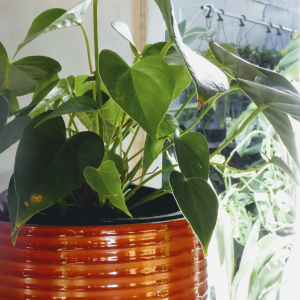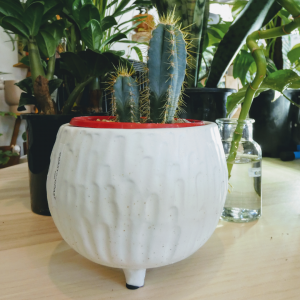If you love potted plant babies and they’ve been a source of joy for you during COVID-19 lockdowns, then we have something for you!
Potted plants indoors can have many health and aesthetic benefits, but have you ever wondered if indoor plants help with asthma or allergies by filtering the air?
For most people, generally speaking, it is a plant’s pollen or scent that causes it to be a trigger for asthma or that terrible repetitive sneezing. So as a rule of (green) thumb, the best plants for people with asthma and allergy will be ones that don’t produce a lot of pollen – but we know everyone is different so keep that in mind
We love our house and office plants, and we know you do too. So, we’ve dedicated our time to finding out the best ones to have indoors and whether they do help with indoor ‘air nutrition’.
Plants and Healthier Indoor Spaces
Some plants can do a better job at indoor ‘air nutrition’ or just survive better if you’re a little bit neglectful. Studies are mostly conflicted on how effective plants are for cleaning the air inside a home or apartment. What they do conclude is that plants help to remove Volatile Organic Compounds (VOCs) from the air around us (that’s emitted by things we use around the house such as cleaners and glues known as formaldehyde, benzene and toluene). However, various studies particularly this one published in the National Geographic suggest whilst plants help, they do it at such a miniscule rate that you’d need around 10 plants per square foot to reduce VOCs enough to impact air quality.
But let’s not get down on our little green friends. There’s plenty of reasons to love them in our homes -we just shouldn’t put too much pressure on them to clean our air (unless you have an indoor jungle).
The best way to have good ‘air nutrition’ inside our homes is to remove sources of pollution in the first place. You can read more about our top tips for clean air indoors, in our blog here.
There is loads of information on the internet about plants. But there is still loads of research to do on how hard our plant friends can work. Please consider that there’s gaps in the existing research
Great Indoor Plant Choices for People with Allergies, Hay Fever & Asthma
Whilst we’re being real about how much our leafy friends can clean our indoor air, some plants are still better for sensitive groups. We’ve compiled a solid list of potted plant friends to add to your family. Whether it is a cute climber near the kitchen window, or a larger living room beauty – they could help you feel better and healthier. There is proven research on the benefits of caring for plants for your mental health.
All these plants are low-allergy and have lots of upsides, not to mention a fantastic range of colours, textures and shapes for decorating our homes.
Pothos: Jade Pothos, Marble Pothos, Golden Pothos
Pothos is commonly known as the Devil’s Ivy – and this name comes from its ability to remain green even in low-light conditions, and its robust nature that makes it incredibly hard to kill.
Pothos is known as one of the easiest plants to maintain indoors. It is a great plant to start your collection and is particularly popular for people beginning their indoor plant journey.

Philodendron: Heartleaf Philodendron, Imperial Green
A quick growing tropical plant that loves to climb trees, Philodendron is often remembered by for the iconic heart-shaped leaves that many of its varieties display. Like the previously mentioned Pothos, Philodendrons are robust indoor plants with minimal maintenance requirements.
A word of warning, Philodendrons can be poisonous to people and animals – so be aware of this if you are thinking about selecting this plant with pets or young children in your household.

Dracaena: Snake Plant, Florida Beauty, Marginata, Lucky Bamboo
Dracaenas are sometimes known as ‘false palm trees’ and have many of the aesthetic properties of palms. This includes long slender stems and tropical looking leaves. Care needs to be taken with these plants not to overwater, as they are used to drier climates and conditions.
Dracaena needs lighter rooms than the previously listed plants, and you will need to find the right spot in your home – ideally with bright, yet indirect sunlight.

Cacti: Saguaro Cactus, Barrel Cactus, Old Lady Cactus
Cacti are an excellent choice for people after a low-maintenance plant with low watering needs. These hardy plants have different aesthetics to the other plants in this list and are known for their weird and wonderful structures.
From thorny exteriors to impressive flowers, cacti add great contrast and shapes to rooms. However, care needs to be taken with any cactus that flowers periodically, as these may contribute to allergies. We recommend moving them outside if they cause problems during these times of year if these issues are noticeable.
The good news is all these plants are popular and widely available. If you are worried about your local availability of varieties, we suggest contacting your local nursery and asking for advice. These groups of plants are a suggestion, and there are many more varieties available.
Things to watch out for
Potted plants love routine care and keeping them healthy brings life to your home. It’s also important that you keep them healthy, otherwise, they can have the opposite effect on your health. Here’s how.
Dusting your plants can be a great technique for minimizing asthma and allergy triggers. This involves using a damp cloth to wipe down the leaves and remove excess dust on a regular basis. Not only does this help keep the plant healthy, but it also helps keep us healthy too!
Be careful not to overwater as it can promote mould growth. This is not only bad for your plant but can also produce spores which can also be bad for your asthma and allergies.
However, not all plants are created equal. Staying clear of pollen-producing plants is a crucial part of keeping harmony and balance in your home. The worst of these plants are generally wind pollinators. You can find out more about wind pollinators here.
We’d like to thank @allthegreenthingsbrisbane for letting us take photos of their beautiful plants. You can find them at www.allthegreenthings.com





 1800 278 462
1800 278 462



